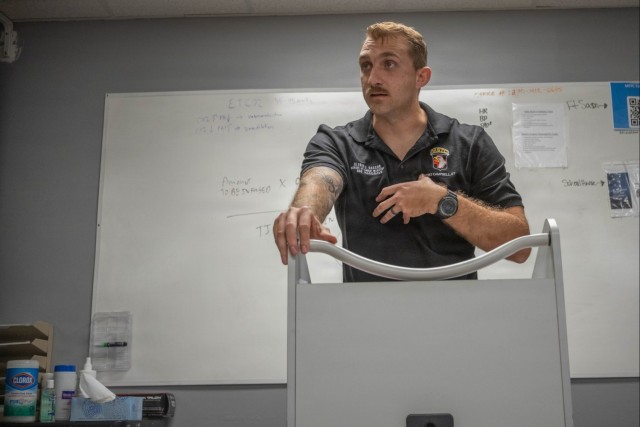
FORT CAMPBELL, Ky. – In front of you is an off-white sheet metal warehouse. It sits along an unassuming road next to a mock village where verdant tree tops can just be seen capping each structure. Upon entering the building, you get a handful of classes, some things you already know, some you don’t, some you haven’t done in years. Soon, you enter a training lane, the cool air around you makes wearing your kit just a bit more bearable. In the distance, you can hear artillery pounding the land paired with the rattling echoes of small arms fire. You move through the lane in blurred scenes until suddenly in front of you lies a mannequin simulating a wounded Soldier. It moves, bleeds, screams. You freeze for just a moment, barely able to hear the instructor directing you over the swell of your growing nerves. You are a Combat Medic (68W) at the Rascon School of Combat Medicine, and this is a flashpoint. A brief second to overcome the anxiety, clear away the rust, and engage in the muscle memory of your profession. Inciting this spark is the most important piece of the training because the instructors know the next flashpoint might not be in a breezy warehouse on a man-shaped piece of plastic.
“Tons of medics are super busy doing their jobs which are really important but we want them to remember ‘I’m a 68W. I’m an expert in trauma medicine,’” said Staff Sgt. Stevan Hargrave, the course coordinator at the Fort Campbell Medical Simulation Training Center (MSTC). “So they come here, we put them out in the dirt with a bleeding casualty, maybe you haven’t done it in a while, cool, you’re gonna figure it out.”

The MSTC team, mostly medics themselves, sees a major significance in the work they do.
“I feel like it’s passing on the torch to the younger medics,” says Hargrave with a pleasant but serious demeanor on his face. “We want them to be knowledgeable and have confidence because when you’re a medic, you’re the guy who’s helping someone on the worst day of their life, so there’s a weight there. It’s not just on them, but psychologically on the medic too.”
Emphasizing the psychological aspect plays first chair in the team’s effort to cultivate a generation of skilled medics.
“When you have to treat your first casualty, that is the flashpoint,” said Hargrave. “There’s really no way to do it without actually doing it, but being able to train medics at this level means getting them as close as we possibly can before that happens.”
Ideally, when the care aspect becomes routine, it will be easier for a medic to overcome the one thing that cannot be replicated. Their first casualty is likely to be someone they know, someone they are friends with, a person who has decided to entrust their life in that medic's hands.

“When you’re a line medic at an infantry unit, there’s a lot of trust in you, you’re part of the team, and when something goes wrong, they look at you,” said Hargrave. “You get there and you become doc-” he clicks his tongue and taps the table before correcting himself. “If you’re good. You have to earn ‘doc.’”
Earning this title means demonstrating confidence in your abilities, taking part in the team, acknowledging the responsibility you hold and ultimately being accepted by the unit to whom you are accountable. For a lot of medics, this aspect comes naturally.
“It’s easy because you know everyone and everyone knows you,” said Sgt. 1st Class Aaron Villa, the MSTC noncommissioned officer in charge. “They treat you like one of them, and every time you prove yourself, then you make them feel safer, more at ease, and more able to do their patrols day in and day out.”
Making a unit feel that sense of security is not a charge that can be filled through one-time acts or the attainment of knowledge in the past. Medics are required to have an unceasing drive toward improvement.
“Don’t be complacent,” said Villa, his eyes narrowed in calculation while his hands gestured with the rhythm of his speech. “Always try to better yourself, always try to learn more so that when you’re in that situation, you know what to do. At the end of the day, you have the power to save someone’s life. You can’t be complacent about that.”
The work done by the MSTC team cannot be easily distilled into any one thing but ending complacency among medics stands as a pillar of their work. Creating a training regime focused on developing the medic corps for the next generation of warfighting also stays at the top of mind.

“With the way conflicts are changing, the things we need to train are obviously different,” said Villa. “That means training in different skills than we have before and making sure they’re ready to use them when the time comes. That’s how you earn that reputation and respect.”
This responsibility owed to medics across the force lends the Rascon building a dual feeling in the air. At once, there is the levity of those doing what they love because they care, and equally the grim seriousness of those doing what they must because they care.
Among these competing moods, Villa and Hargrave stand in front of a whiteboard calendar planning the upcoming schedule. One points out that the next major lane falls on Halloween, and from across the room, a team member, holding a paintball gun, suggests they wear costumes. Everyone laughs, and just for a brief moment, there are no calculating eyes or serious faces, and it feels as though the light tone may win out. Yet, as quick as it came, it leaves, and the building returns to equilibrium. All present focused on giving the best chance to a Soldier who will one day have a life in their hands.




Social Sharing